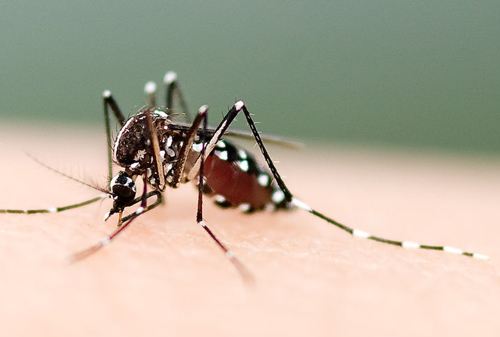(单词翻译:单击)
听力文本
This is Scientific American — 60-Second Science. I'm Karen Hopkin.
Sucking blood is risky business. At least for the female mosquitoes that need those nutrients to nurture their developing eggs. Not only do these bugs have to find a suitable blood donor, but once they've had their fill, they have to be able to escape undetected—to avoid the big swat. How they finesse this stealthy departure has just been revealed in the Journal of Experimental Biology.
Feasting on an unsuspecting mammal can double a mosquito's body mass. So how does a fully loaded female heave that added bulk off the skin of her host without triggering its pressure sensors and bringing on that fateful slap? To find out, Florian Muijres of Wageningen University in The Netherlands and his colleagues used cameras that record 13,500 frames per second to capture the takeoff maneuvers of 63 blood-fed malarial mosquitoes.
What they discovered is, when it comes to a soft yet speedy getaway...for female skeeters, the wing's the thing. With a wingbeat frequency of about 600 beats per second...the insects are able to lift themselves lightly off their host. That approach is the opposite of the one favored by most other winged things, says Muijres.

"Most flying animals when they take off, like birds or a fly for, example, they first use their legs to push off very hard, and then when they are in the air, then they start beating their wings and generate aerodynamic lift to be able to fly away. Mosquito does it the other way around. It first starts beating its wings and through the aerodynamic forces these wings generate, their body is being lifted off from the substrate. And then they do gently also push down with their long legs to be able to further power their liftoff. But these forces that are being generated by the legs are relatively small."
In fact, the faint flutter of a mosquito's wings produces less than one third of the force exerted by similar-sized but much less subtle fruit flies as they shove off in search of another banana. And even on a full stomach, these bloodsuckers are stunningly fast, says Muijres. "So takeoff phase takes only about 30 milliseconds, which is 10 times faster than how fast we can blink our eye." And they're gone before we know what hit us. And before we can hit them.
Thanks for listening for Scientific American — 60-Second Science. I'm Karen Hopkin.
参考译文
这里是科学美国人——60秒科学。我是凯伦·霍普金。
吸血是件危险的事儿。至少对需要营养来发育蚊卵的雌蚊子来说是危险的。它们不仅要寻找合适的供血者,还要能在吸饱血后悄悄溜走,以避免被拍死。《实验生物学期刊》上发表的一篇文章揭示了蚊子逃走的妙计。
蚊子在毫不知情的哺乳动物身上饱餐一顿之后,体重可以增加一倍。那吸满一肚子血的雌蚊子是如何带着增重的身体离开宿主的皮肤,而又能不触发宿主的压力传感器,避免招致致命一掌的呢?为了找到答案,荷兰瓦赫宁恩大学的弗洛里安·穆依列斯和同事用每秒13500帧的摄像机拍摄了63只携带疟疾的蚊子在吸满血后起飞时的动作。
他们发现,雌蚊子能轻柔且敏捷地飞走,是它们的翅膀在发挥作用。凭借每秒约600次的振翅频率,雌蚊子能轻巧地飞离宿主。穆依列斯说,大多数有翼昆虫喜欢用的方法与蚊子正相反。
“鸟或苍蝇等大多数飞行动物在起飞时,会先用力蹬腿,然后在空中开始拍打翅膀,以产生气动升力来飞走。蚊子却用相反的方式来做。蚊子先是振动翅膀,凭借翅膀产生的空气动力,它们的身体被抬升,离开基底。然后,蚊子也会轻轻地蹬腿,进一步为升空提供助力。不过蚊子的长腿所产生的力量相对较小。”
事实上,蚊子翅膀的微弱振动所产生的力量,不到果蝇离开去寻找另一根香蕉所产生力量的三分之一,而果蝇的体型与蚊子相当,但却远不如蚊子机智。穆依列斯认为,即使吸了满肚子的血,这些吸血动物的神速依旧惊人。“它们的起飞过程仅用时30毫秒,比我们人类眨眼的速度快10倍。”在我们意识到被它们叮咬之前,在我们能拍到它们之前,蚊子就已经飞走了。
谢谢大家收听科学美国人——60秒科学。我是凯伦·霍普金。
译文为可可英语翻译,未经授权请勿转载!
重点讲解
重点讲解:
1. when it comes to 谈到;涉及;
例句:When it comes to integrating their transport systems, the French don't miss a trick.
法国人从不放过任何整合其交通系统的机会。
2. take off 起飞;
例句:The plane is about to take off.
飞机就要起飞了。
3. the other way around 相反地;倒过来;
例句:To much of the rest of the world, however, it looks the other way around.
然而,对于世界上的许多其他国家来说,情况正好相反。
4. in search of 寻找;寻求;
例句:Marian retains a restless, youthful spirit, in search of new horizons.
玛丽安怀着一颗年轻、不断进取的心去寻求新的天地。


